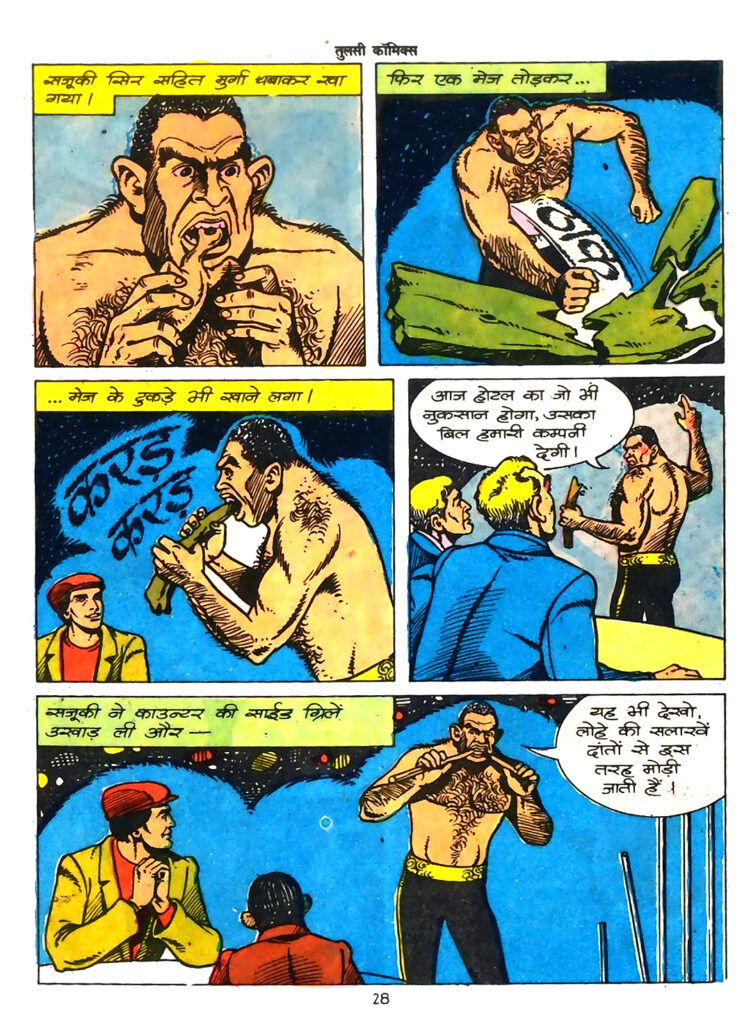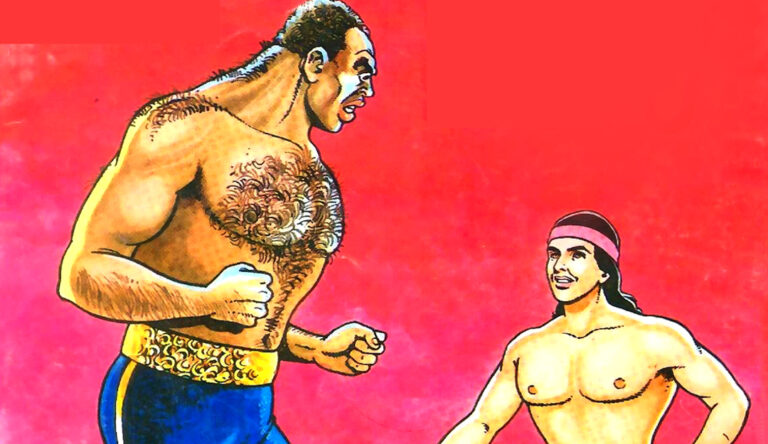The golden era of Indian comics, which shone brightest in the 80s and 90s, was a time when children’s and young people’s imaginations took flight with heroes brought to life on paper. Be it Nagraj and Dhruv from Raj Comics or Chacha Chaudhary and Billu from Diamond Comics, each character won countless hearts. Meanwhile, Tulsi Comics carved out its own unique identity. Many of Tulsi’s characters became famous, but the most memorable name among them is Angara.
Angara was more than just a superhero – he was the voice of nature and the protector of animal rights. Today, we’ll talk about one of his most remarkable stories from Tulsi Comics, “Azadi Ki Jung” (The War of Freedom). This story is not only an exciting adventure but also carries a deep, forward-thinking message. Parshuram Sharma’s powerful writing and Pradeep Sathe’s striking artwork make it truly special.
Story: A War of Freedom
“The War of Freedom” begins right after Angara liberates his island by defeating American forces. His dream is to turn this land into a place where animals from across the world can live freely and safely. He believes that forests are slowly becoming barren of wildlife, and humans have become their greatest enemies.
To bring his dream to life, Angara sends his massive and intelligent Garuda bird, Jatayu, on a mission – to find a place where animals of every kind live together, so they can later be brought to Angara’s island.
Jatayu obeys and sets out. After a long journey, exhausted and thirsty, he stops to drink from a lake. But fate had something else in store. Two hunters – Harry and Timtang – were already there. The moment their eyes fell on the magnificent bird, greed consumed them. They realized that capturing such a creature could make them millionaires.
Using an old trick, they mixed fainting powder into the lake’s water. Unaware, Jatayu drank it, and soon collapsed. The hunters quickly captured him with the help of local Bhils and took him to their base. Clever Harry then invited zoos from around the world to an auction. In the end, the highest bid came from a zoo owner in New Jersey.

Caged and shipped across the seas, Jatayu arrived in New Jersey. With a heavy heart, he looked around and saw lions, tigers, elephants, giraffes, zebras, and countless other animals trapped in cages. Suddenly, he remembered Angara’s mission – this was the very place he had been searching for. But tragically, he himself was now a prisoner.
Determined to act, Jatayu first tried talking to a nearby elephant, but the poor creature was broken in spirit. The electric whip of the ringmaster had crushed his courage, and he advised Jatayu to stay quiet.
Disheartened, Jatayu then noticed a sly chimpanzee. He shared his plan with him and spoke of Angara’s kingdom. The chimpanzee, later named Mr. Don, agreed to help – but on one condition: Angara must make him the “President” of his kingdom. Reluctantly, Jatayu accepted the deal.
Mr. Don soon showed his cunning. Sneaking into the ringmaster’s room, he stole the keys and unlocked Jatayu’s cage. But the moment Jatayu stepped out, the alarm blared, and guards rushed in. Jatayu took flight with Mr. Don on his back, and after a long struggle, they reached Angara’s island safely.
Overjoyed, Angara welcomed his loyal friend and, keeping his word, declared Mr. Don the first President of the “Animal Republic.” But the next and far bigger mission was already clear – they had to go back to New Jersey and free the rest of the caged animals. At this point, the story ends on a powerful cliffhanger, leading readers eagerly into the next issue, “Angara Hi Angara.”
The Characters that Brought the Story to Life
Angara: The heart and soul of the story. Angara isn’t a typical superhero who exists only to save humans. His mission is to liberate animals from human cruelty. With the skin of a rhinoceros, the mind of a fox, the strength of an elephant, and the heart of a lion, Angara is an invincible warrior. But his greatest power is his determination and boundless love for animals. He’s a true leader who values friendship and loyalty above all.

Jatayu: More than just Angara’s mount, Jatayu is his most loyal companion and a wise figure in his own right. The central portion of the story revolves around him – his capture, struggle, and resilience. Devoted to Angara, he risks his life to fulfill the mission.
Mr. Don (the Chimpanzee): This character adds both humor and cleverness to the narrative. His obsession with becoming “President” makes readers laugh, but it also symbolizes something deeper – that animals, too, desire respect and leadership. His wit and daring theft of the keys make him crucial to the story.
The Villains: The story features villains on two levels. First are Harry and Timtang, greedy hunters who capture animals for profit. Then comes the ringmaster of the zoo – a symbol of institutional cruelty. His electric whip embodies the harsh domination of humans over animals. Together, these villains highlight the central conflict of the story: nature versus greed, freedom versus captivity.
Art and Illustrations
Pradeep Sathe’s artwork breathes life into this world. His illustrations may be simple, but they’re highly effective. The emotions shine through – the pain in the animals’ eyes, Jatayu’s dignity, Mr. Don’s sly grin, and Angara’s confidence are all portrayed vividly. Action scenes burst with energy, while the color palettes shift with the mood – lush greens for forests, dark and tense tones for captivity. The panel layout is clean and easy to follow, keeping the narrative flowing smoothly. Overall, the artwork perfectly complements the story and pulls readers into Angara’s world.
The Deeper Message of the Story

Through an adventure narrative, Parshuram Sharma delivers a surprisingly profound message. “The War of Freedom” isn’t just about animals breaking free from cages – it’s about the right of every living being to live free. The comic raises some thought-provoking questions:
- Animal Rights: Do humans have the moral right to imprison animals for entertainment or profit? Angara’s very existence challenges this notion.
- Environmental Protection: The story highlights concerns about forests being emptied of wildlife – pointing to deforestation and poaching, issues even more pressing today.
- Human-Animal Relations: Angara’s words to his followers – that “no animal is the enemy of a human” – reflect the story’s core philosophy: coexistence.
Remarkably, these ideas, written in the 90s, remain just as relevant today. Debates about the ethics of zoos continue, and laws against animal cruelty are stricter than ever. In many ways, these comics were ahead of their time.
Conclusion
“Azadi Ki Jung” is a shining example of Tulsi Comics at its best – blending entertainment with a meaningful message. It takes readers on a thrilling adventure while inspiring them to respect nature and its creatures. Angara teaches us that true courage isn’t just about strength – it’s about standing up for those who cannot speak for themselves.
This comic is not only a nostalgic gem for those who grew up reading it but also a vital story for new generations. It reminds us that comics are more than flights of fancy; they can also inspire us to view the world with compassion and empathy. Truly, “The War of Freedom” is a timeless saga of liberation.
